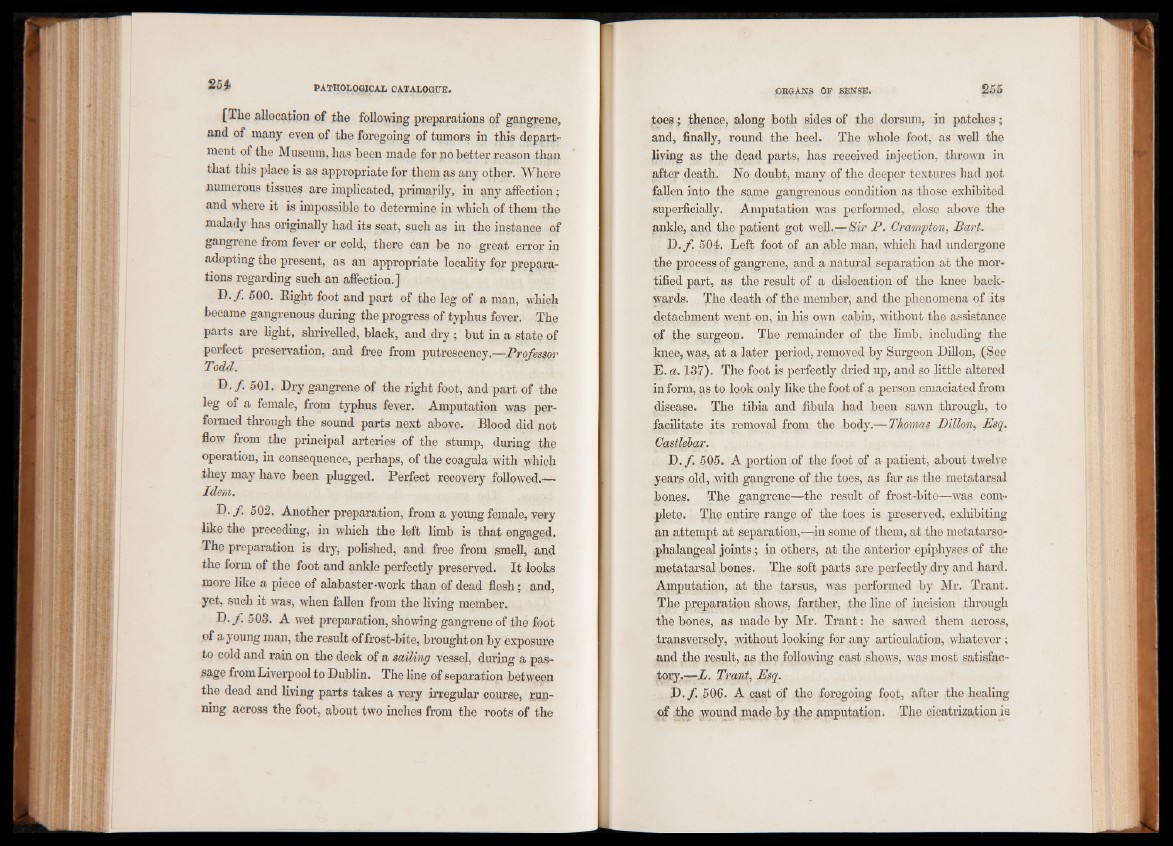
[The allocation of the following preparations of gangrene,
and of many even of the foregoing of tumors in this depart"
ment of the Museum, has been made for no better reason than
that this place is as appropriate for them as any other. Where
numerous tissues are implicated, primarily, in any affection;
and where it is impossible to determine in which of them the
malady has originally had its seat, such as in the instance of
gangrene from fever or cold, there can be no great error in
adopting the present, as an appropriate locality for preparations
regarding such an affection.]
D. ƒ. 500. Right foot and part of the leg of a man, which
became gangrenous during the progress of typhus fever. The
parts are light, shrivelled, black, and dry ; but in a state of
perfect preservation, and free from putrescency.—Professor
Todd.
D - f 501. Dry gangrene of the right foot, and part of the
leg of a female, from typhus fever. Amputation was performed
through the sound parts next above. Blood did not
flow from the principal arteries of the stump, during the
operation, in consequence, perhaps, of the coagula with which
they may have been plugged. Perfect recovery followed.—
Idem.
D. ƒ. 502. Another preparation, from a young female, very
like the preceding, in which the left limb is that engaged.
The preparation is dry, polished, and free from smell, and
the form of the foot and ankle perfectly preserved. It looks
more like a piece of alabaster-work than of dead flesh; and,
yet, such it was, when fallen from the living member.
D. f 503. A wet preparation, showing gangrene of the foot
of a young man, the result of frost-bite, brought on by exposure
to cold and rain on the deck of a sailing vessel, during a passage
from Liverpool to Dublin. The line of separation between
the dead and living parts takes a very irregular course, r.un~
ning across the foot, about two inches from the roots of the
toes; thence, along both sides of the dorsum, in patches;
and, finally, round the heel. The whole foot, as well the
living as the dead parts, has received injection, thrown in
after death. No doubt, many of the deeper textures had not
fallen into the same gangrenous condition as those exhibited
superficially. Amputation was performed, close above the
ankle, and the patient got well.—Sir P. Crampton, Bart.
D. f. 504. Left foot of an able man, which had undergone
the process of gangrene, and a natural separation at the mortified
part, as the result of a dislocation of the knee backwards.
The death of the member, and the phenomena of its
detachment went on, in his own cabin, without the assistance
of the surgeon. The remainder of the limb, including the
knee, was, at a later period, removed by Surgeon Dillon, (See
E. a. 137). The foot is perfectly dried up, and so little altered
in form, as to look only like the foot of a person emaciated from
disease. The tibia and fibula had been sawn through, to
facilitate its removal from the body.—Thomas Dillon, Esq.
Castlehar.
D. ƒ. 505. A portion of the foot of a patient, about twelve
years old, with gangrene of the toes, as far as the metatarsal
bones. The gangrene—the result of frost-bite—was complete.
The entire range of the toes is preserved, exhibiting
an attempt at separation,—in some of them, at the metatarsophalangeal
joints; in others, at the anterior epiphyses of the
metatarsal bones. The soft parts are perfectly dry and hard.
Amputation, at the tarsus, was performed by Mr. Trant.
The preparation shows, farther, the line of incision through
the bones, as made by Mr. Trant: he sawed them across,
transversely, without looking for any articulation, whatever;
and the result, as the following cast shows, was most satisfactory.—
A. Trant, Esq.
D. ƒ. 506. A cast of the foregoing foot, after the healing
of the wound made by the amputation. The cicatrization is